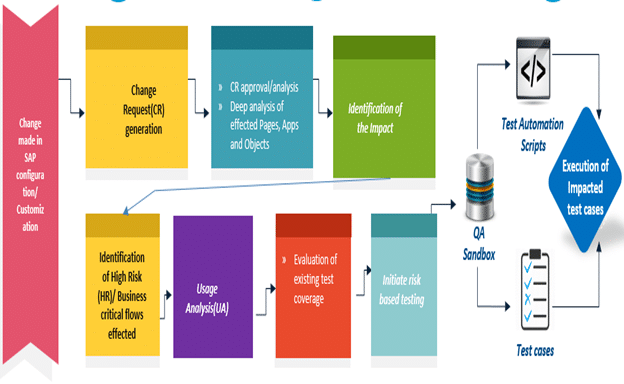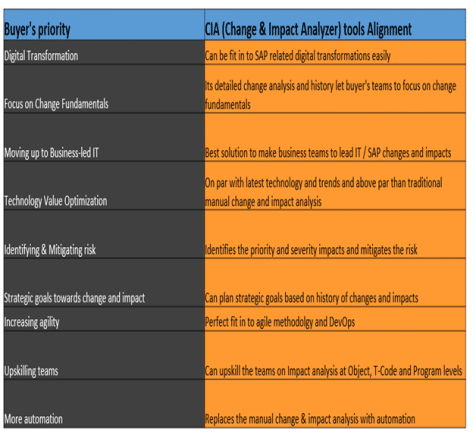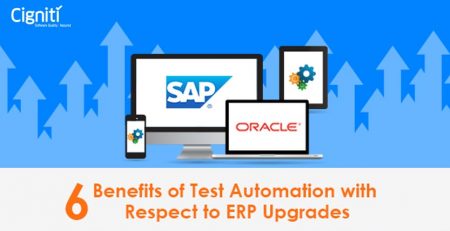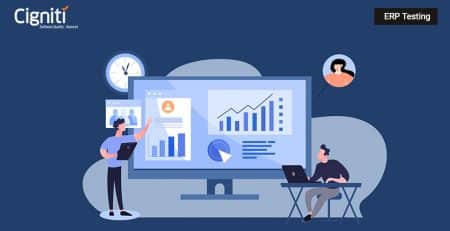Change and Impact Analysis in SAP World and Its Relevance to Testing
Enterprise customers have their business operations spread across the globe, and their business requirements change frequently to meet the everchanging customer needs.
Business managers are frequently astounded by the lack of agility in their SAP applications. SAP support managers should optimize their change management processes to adapt to their live SAP business processes faster without compromising system integrity.
So, while reviewing and optimizing any SAP change management process, the following five basic steps are to be considered: Impact Analysis, Governance Process, Application Changes, Testing, and Transport Management.
Gartner says, “To optimize the reliability and agility of your SAP change management process, evaluate the use of software tools to automate the operation of each step in the process: a regular review of all SAP change requests; simplify and automate key steps in the change management process; focus on speed for small business enhancements; and improve the delivery of large business projects.”
Why Change and Impact Analysis
Enterprise customers use SAP applications for their day-to-day business operations. Here, change is unavoidable in SAP applications as the business requirements change frequently due to business expansion, presence in multi-geographical locations, the introduction of new applications in the IT landscape, enhancements for the missing functionalities, and more.
It is important to analyze the changes and their respective impacts to avoid the risks of breaking the existing functionalities and creating chaos among various business teams operating in different geographies.
Customers should also know whether the existing test coverage is enough to test the frequently occurring changes or whether they should create additional tests because of the changes and impacts.
Procedure to Perform Change and Impact Analysis
A streamlined process should be in place to perform change & impact analysis in SAP applications. The procedure may vary from customer to customer, based on their business operations, but the below diagram illustrates such a procedure to be followed as per best practices.
The data of enterprise customers is huge, and their application landscape is complex. Some customers may use multiple ERPs and third-party applications that are tightly integrated with SAP applications.
A change in one SAP module might impact other modules in that application. Similarly, a change in the SAP application might impact several business transactions/processes across various interconnected systems as well.
There are incidents where enterprise-level customers have lost revenue in millions because of unknown changes and impacts in production that were not tested by the business teams responsible across the globe, as they were not aware of the changes that happened in their SAP systems.
Customers have thousands of test cases, and they need to execute them all because they lack surety about which test cases might be impacted by the unknown changes, and this consumes a lot of time and cost.
Since business teams remain busy with their regular operational activities, they won’t have much bandwidth to accommodate and address this challenge.
Testing without Impact Analysis
A change that happens based on the request of a business team in one geographical region may not be known to the business teams in other geographical regions.
This change will impact their regular business operations if the change and impact are unknown. If changes and impacts are not tested in regular release cycles, then the chances of production getting impacted by defects increase manifold.
There is a possibility that integrations across modules and products might also break down if you perform testing without knowing the changes and impacts.
Change & Impact analyzer tools Integrate Dev and Ops to Reform Testing
These automated tools will perfectly fit into your DevOps and agile environments. They can provide detailed reports on the changes and impacts triggered in your SAP applications.
They can also suggest your test coverage gap and propose the additional tests that need to be developed to complete your test coverage.
By using these tools, customers can automatically identify the risk category (high, medium, low risks) and can define their priority (high, medium, low) and severity level as well. Based on the available time frame, customers can perform these categorized testing.
Release Management using Change & Impact analyzer tools
These automated tools will perfectly fit into your DevOps and agile environments. They can provide detailed reports on the changes and impacts triggered in your SAP applications.
They can also suggest your test coverage gap and propose the additional tests that need to be developed to complete your test coverage.
By using these tools, customers can automatically identify the risk category (high, medium, or low risk) and can define their priority (high, medium, or low) and severity level as well. Based on the available time frame, customers can perform this categorized testing.
Benefits of Change & Impact analyzer tools
Here are some of the benefits of the Change and Impact Analyzer Tools:
- Test only what is required
- Identify and track the changes in SAP application
- Identify the impacts of objects, T-codes and programs
- Know the priority and severity of the impact
- Understand which existing test cases are impacted
- Identify test coverage gap
- Manage release cycles efficiently
Buyer’s priority and CIA tools alignment
Change is inevitable in SAP applications. Digital transformations, business process re-engineering, functionality enhancements, configurations, customizations, and more will always trigger changes in SAP applications.
If changes are unknown to other business teams, it will be a tedious job to find out the business impacts. Hence, the changes in SAP applications need to be analyzed properly and the impacts need to be diagnosed effectively. Here, the test coverage gap should be identified, and new tests need to be designed due to changes and impacts in SAP applications.
Performing change and impact analysis manually will consume a lot of effort. As a result, it is recommended that customers use change and impact analyzer tools, which will assist them not only in identifying and tracking changes and impacts, but also in identifying the existing test coverage gap and obtaining information on what new tests should be added to a repository. Tools will also suggest the priority and severity of the impacts and tests.
Thus, it will be useful for customers to perform automated change and impact analysis and reduce the risk of changes and their impacts.
Cigniti has built its own SAP Change and Impact Analyzer tool with a lot of features that will help the customer to do change analysis, impact analysis, test coverage gap analysis, usage analysis, priority, severity, etc.
Cigniti’s SAP experts have built this tool as a one-click solution for all changes and impacts of SAP applications. This tool is above par with many CIA (Change and Impact Analysis) tools in the market in terms of its user-friendliness, features, benefits, etc. R&D is still going on, and Cigniti’s tool specialists are continuously adding additional features to it.
Need help? Consult our SAP Testing experts to learn more about this revolutionary tool and the change and impact analysis in the SAP world and its relevance to testing.





Leave a Reply